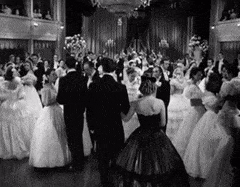There were etiquette books before Emily Post’s Etiquette in 1922. But she set a new standard in how to write about Perfect Propriety and, without realizing it, became the grandmother of all American etiquette writers. So what could be more Perfectly Proper than that her great-great-grandchildren, Lizzie Post and Daniel Post Senning, set a new standard themselves to honor the 100th anniversary of Emily’s legacy? Emily Post’s Etiquette: The Centennial Edition is the definitive etiquette book for our times, streamlining Emily’s charm and correct instincts into engaging, readable prose for 21st-century situations. Etiquetteer couldn’t be more pleased; buy this book.
One of the most prominent things that’s changed about how Americans think of manners is that they don’t feel the need to ape the rich or take their cues from aristocratic ladies*. And the authors acknowledge this almost right away. “While Emily’s status in society was that of an older, wealthy white woman, her advice was anchored in principles that were effective and accessible for all, creating a long-lasting and adaptable foundation for her work.” Throughout the new edition, other cultures and traditions are treated sensitively, something most etiquette books rarely had to consider in Emily’s day. We recognize that traditions of good behavior come from many different places.
Emily’s language reflected her upbringing and status, and Etiquetteer has always found her books charming . . . if a bit rambling**. The authors of the centennial edition have taken a different, less remote approach: “We hope it will feel like a conversation about etiquette and not like an encyclopedia.” They have achieved this goal hands down, making the centennial edition just as tough to put down as Emily’s books, but with a fresh new Postian voice. Etiquetteer just hankers to chat with them over coffee.
One reason Emily Post’s books were fun for a little boy to read was her cast of characters: The Worldlys, the Oldnames, the Eminents, the Onceweres, Mr. Clubwin Doe, and of course the Gildings. “It will not do to ask the Bob Gildings, not because of the difference in age but because Lucy Gilding smokes like a furnace straight through dinner and is miserable unless she can play bridge for high stakes . . . while Mrs. Highbrow and Mrs. Oncewere quite possibly disapprove of women’s smoking at all and class all playing for money with ‘gambling.’”*** Mrs. Toplofty’s solution to sitting next to a mortal enemy at dinner remains an important moment in that edition. Mrs. Toplofty doesn’t appear to have survived in the centennial edition, nor Mr. Richan Vulgar and Miss Nono Betta. But Ms. Travelswell joins us, as well as Ms. Inher Heade, Mr. Chival Russ, and Mx. Dullasa Doorknob. Etiquetteer loves them.
Yes, Mx., pronounced Mix. The authors actively embrace the honorific for nonbinary, intersex, and gender-nonconforming people, the greatest shift in the etiquette world since the creation of Ms. “Name and pronoun changes are often part of a person’s transition [from one gender to another] or nonbinary identity, and recognizing any such changes and using a person’s correct names and pronouns is key to showing them support, respect, and basic courtesy.” [Emphasis Etiquetteer’s.] It took about ten years for Ms. to become unremarkable, so Etiquetteer predicts most people will be comfortable with Mx. by 2028. And they note that standards are changing to be less rigid: “A glorious dinner party today can allow us to enjoy gathering and celebrating . . . while no longer requiring us to alternate seating or divide activities by binary gender standards of old . . . anyone who’d like to may head to the study for an after-dinner cigar.”
Etiquetteer does not always agree — perhaps there will be another column later on where Etiquetteer just isn’t yet ready to follow — but everything the authors recommend is given with reasons why manners have evolved. Emily Post’s Etiquette: The Centennial Edition presents a blueprint for a kinder, more Perfectly Proper world. “Etiquette can be learned and employed by anyone,” they write, “at any stage in life, and is a choice that is available to all of us.” Etiquetteer has always referred to going back to Emily Post as “drinking the Pure Milk of the Word.” Now it comes in a delicious new flavor! Etiquetteer is going to curl up in a comfortable chair and start rereading it already. Buy this book. What could be more Perfectly Proper?
*There is a great difference now between Those Who Are Rich and Those Who Are Aristrocratic.
**Etiquetteer is not one to talk, and sees the fingers pointing back at him.
**1950 edition, page 331. How can you not love this?

































